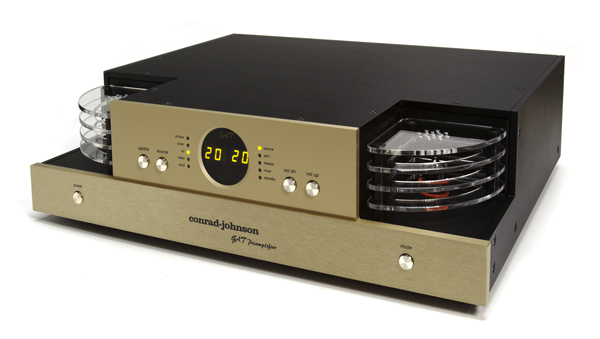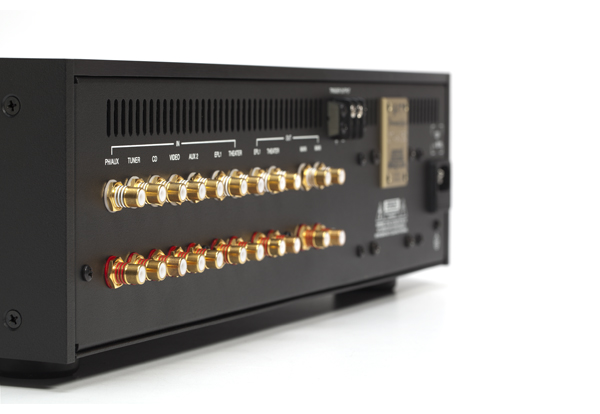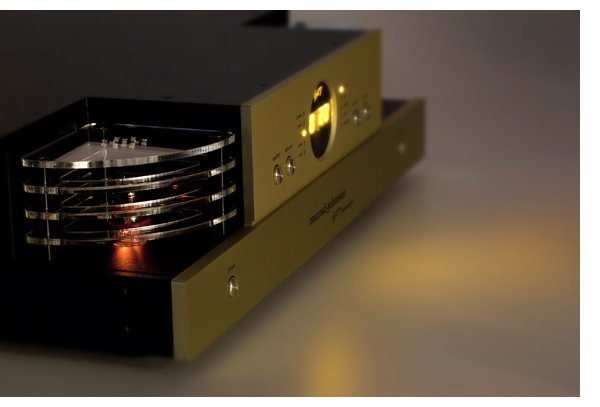Conrad Johnson GAT Preamplifier Triumph Over Mediocrity
By Jeff Dorgay My journey with Conrad-Johnson preamplifiers goes all the way back to its original PV-1, purchased new in 1979. Over the last 33 years, I’ve tried a number of different preamplifiers, yet the CJ sound remains a favorite.
My journey with Conrad-Johnson preamplifiers goes all the way back to its original PV-1, purchased new in 1979. Over the last 33 years, I’ve tried a number of different preamplifiers, yet the CJ sound remains a favorite.
Loyal TONEAudio readers know that I’ve been using the ACT 2/series two preamplifier for many years as a reference component. Just like that PV-1, the ACT 2 has performed without as much as a burp—along with the company’s Premier 350 power amplifier—for upwards of 20,000 hours. During a recent dinner with Lew Johnson, he and his partner, Bill Conrad, laughed and said, “You’ve probably spent more hours listening to the ACT 2 than we have. And we designed the damn thing.”
The ART 3 hit the scene a few years ago, and while I enjoyed listening to it in a few friends’ systems, I was too content with the ACT 2 to let it go. However, the GAT is another story. When I visited the CJ factory last year, Johnson said, “I think we finally have something you’ll want to trade your ACT 2 in on.”
While CJ has always made all-vacuum-tube preamplifiers, the GAT marches to the beat of a different drum. Produced in an edition of 250 units, each $20,000 GAT has a small, stamped serial-number pad on the back face. It is also the ultimate in simplicity. Only one 6922 vacuum tube is utilized as a gain stage per channel, and a low-noise FET transistor serves as an output gain buffer—an alternate approach from models employing the FET as the input stage. The combination works brilliantly, offering low noise and incredible low-level detail.
Under the Hood
Much has been said about the virtues of the proprietary Teflon CJD capacitors transforming CJ electronics from a slightly warm, mellifluous sound that this writer always finds enticing to a current sound that gives up none of the tonal richness from legacy designs, yet now possess a level of large- and small-scale dynamics—along with a transparency unattainable in previous preamplifiers. As they used to say at Weight Watchers, “All the satisfaction with none of the guilt.”
The GAT is full of the aforementioned large capacitors, strategically placed in all critical functions. Those used in the power supply look like emergency road flares, and account for much of the GAT’s explosive dynamics. The rest of the circuit board reveals premium parts; this isn’t an overpriced pretty box.
However, those massive Teflon capacitors take some time to sound their best. We have experienced the same trait with every component featuring a number of them in their design. Right out of the box, the GAT sounds a little flat and restricted—almost in a haze. But it’s easy to pick up on the exquisite tonality that makes this preamplifier one of the world’s finest.
The GAT exits the fog once 100 hours pass, and makes a substantial jump in clarity around the 300-hour mark. Should you be a jittery, impatient audiophile, resist the urge to abandon the GAT until you get at least 300 hours on the clock, or you will be sorry. Most of this “break-in” finishes at this point; you’ll know it when you power it up and it just sounds a lot “bigger.” From that point forward, it continues to slightly improve over the next few hundred hours.
The ACT, ART, and GAT all possess their own unique sonic signature, and each appeals to a different listener. The ACT 2 places you about five rows closer to the musical presentation than the ART 3, yet the latter claims more heft in the lowest register of the frequency spectrum, and possesses more tonal saturation as well. Keep in mind, these are not earth-shattering differences. It’s more like the gradation between high-performance tires on a Porsche or Ferrari, but the preamplifiers do have their own unique flavor.
Regardless of your choice of adjectives, these two models owe as much to the type of tube (four 6H30s in the ACT 2, ten 6922s in the ART) as their inherent circuit design.
Enter the GAT. Imagine an equal mixture of the ART and ACT’s tonality, with greater dynamic ability and a lower noise floor. It’s that basic. The GAT makes for a perfect match for both tubed and solid-state CJ power amplifiers, proving a great dance partner with all the amplifiers at my disposal.
Users Chime In
During the course of the review, a few GAT owners were kind enough to send me their impressions, and we’ve all drawn the same conclusion. Whether previous CJ owners or not, all agree that the price asked for the GAT was “very reasonable” in comparison to other units they auditioned. One user called it a “relative steal.”
The GAT’s high-frequency refinement got the highest marks, with one of our respondents feeling the difference between the GAT and ACT 2 isn’t subtle. “It’s as if CJ has brought back the magic midrange from the Premier 16LS and ART preamplifiers, yet carved away the syrupy part.”
All concurred on the GAT’s superior noise floor and, interestingly, the seven GAT owners/responders all commented on the quality of the stock CJ power cord. One reader sums it up succinctly, stating, “I’ve experimented with a number of power cords, and noticed a marginal improvement. But the stock CJ cord is tough to beat.”
Serves the Music
High-performance audio components are like high-performance automobiles in the sense that they offer overpowering excellence in one area, yet lack in others that are even bested by modestly priced competitors. While the GAT is almost equally good with all aspects of musical reproduction, it is the master at combining high resolution with a complete lack of grain or harshness.
Keith Jarrett’s Shostakovich: 24 Preludes and Fugues, Op. 87 instantly reveals the nuance, texture, and decay the GAT puts at your disposal. Leading and trailing edges of piano notes sound magnificent—almost fragile, not unlike the multicolored light reflection on a soap bubble floating in the air. Acoustic instruments portrayed via the GAT are incredibly realistic.
The GAT also excels in the pace department. The title cut of Frank Sinatra’s Nice and Easy reveals the component’s prowess, as it keeps Sinatra’s vocals out in front of his orchestra while simultaneously painting a Cinemascope-esque soundstage behind him. At the end of the track, when he snaps his fingers, this bit of fleeting percussion makes it feel as if the man himself is standing about four feet in front of you—unbeatable.
Anja Garbarek’s “Big Mouth” from Smiling and Waving illustrates how the GAT proves equally captivating with female vocals. In this case, Garbarek’s highly over-processed vocals fill my listening room to the point where, at high volume, the doors need to be opened to let some of them out. Yet, at the same time, all of the cool percussion and electronic sounds hover in space. Crowded House’s Woodface offers the same presentation. Even though it’s another studio album full of processing, and an excellent example of “pinpoint imaging,” the GAT bears fruit.
If you are the type of audiophile that loves the latter effect, the GAT will stun you with its massive soundstage and rock-solid imaging—no doubt because of the GAT’s lightning transient speed and freedom from overhang. It stops and starts without going past the mark, providing fatigue-free sound, even after long listening sessions.
Like any other preamplifier from the top of the mountain, the GAT breezes through pristine audiophile tracks. But those cues aren’t what separate the best from pretty good. As fine as the GAT is with your best recordings, it will endear you with its ability to reveal more music than you thought possible from less-than-heavenly material.
Favorites from Elvis Costello, Bruce Springsteen, and Todd Rundgren (A Wizard, A True Star is particularly nasty sounding) move up from the “terrible recording, but I love the music” to the “sounds pretty good” category. The Rundgren record is particularly splendid when played through the GAT: The bass foundation is better than I’ve ever heard it, along with a few more layers.
I can’t stress the importance of these revelations when it comes to an expensive component. It’s imperative that gear that costs as much as a decent car doesn’t limit the user to five audiophile-approved recordings. This alone justifies the price for this reviewer. Grab a GAT before they are gone.
Conrad Johnson GAT Preamplifier
MSRP: $20,000
Peripherals
| Analog Source | AVID Acutus Reference SP/TriPlanar/Lyra Atlas |
| Digital Source | dCS Paganini stack Sooloos Control 15 |
| Phonostage | Vitus Audio MPP-201 |
| Power Amplifiers | Conrad Johnson Premier 350 Pass Labs XA200.5 Burmester 911 mk. 3 Octave Jubilee Monoblocks |
| Speakers | Magnepan 3.7 GamuT S9 |
| Cable | Cardas Clear |




